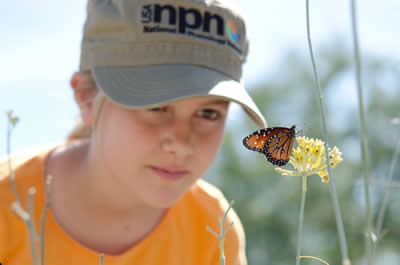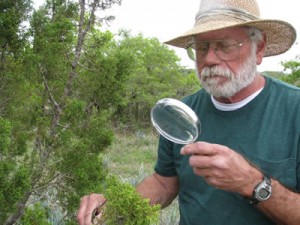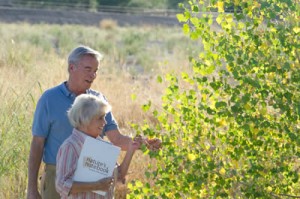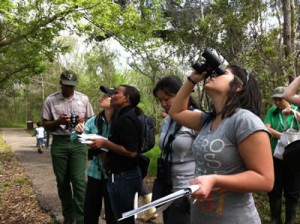 A young Nature’s Notebook participant observes a queen butterfly feeding on a milkweed plant. Photo credit: Brian Forbes Powell.
A young Nature’s Notebook participant observes a queen butterfly feeding on a milkweed plant. Photo credit: Brian Forbes Powell.Nature’s Notebook | Citizen Scientists Track Seasonal Change
Case Study Overview
 A young Nature’s Notebook participant observes a queen butterfly feeding on a milkweed plant. Photo credit: Brian Forbes Powell.
A young Nature’s Notebook participant observes a queen butterfly feeding on a milkweed plant. Photo credit: Brian Forbes Powell.For hundreds of years, amateur naturalists — the citizen scientists of their day — recorded seasonal events such as flowering in spring or bird migrations in fall. In the late 1950s, for example, volunteers across the country mailed their observations about lilacs and honeysuckles to the U.S. Department of Agriculture.
In 2007, the U.S. Geological Survey, National Science Foundation and other organizations joined together to found the USA National Phenology Network. “Phenology” refers to seasonal cycles in plant and animal communities, such as flowering and animal migrations. The USA-NPN is designed to promote phenology as a tool for understanding and adapting to changing environments.
Scientists alone cannot collect all the phenological data they need — not without the help of volunteers. Capitalizing on widespread public interest in the seasonal workings of nature, the USA-NPN established Nature’s Notebook, a national citizen science project. Project volunteers regularly record observations of plants and animals online to generate long-term datasets used in science and policymaking.
Download this case study (PDF, 138KB)
Website: Nature’s Notebook
Project Description

A Nature’s Notebook volunteer observes juniper pollen development. Photo credit: Mechelle Meixner.
No previous knowledge or experience is necessary to participate in the project, and the time commitment for volunteers is low — about 10 minutes a few times a week. Volunteers join Nature’s Notebook and set up an account. They choose a site they want to observe, such as their own backyards. Then they select the plants or animals that interest them from a list of species.
After familiarizing themselves with the standardized Nature’s Notebook observation protocols, the volunteers record observations on a paper datasheet and then enter their observations online. Alternatively, volunteers can report observations using mobile apps available for both iPhone and Android platforms. The observation protocols used in Nature’s Notebook have been published in the peer-reviewed literature.
The Nature’s Notebook database compiles information on plant and animal phenology from across the United States for over 1,000 species of plants and animals. The data are widely shared among scientists, policymakers and natural resource managers. As of early 2015, over 5 million records of plant and animal phenology had been contributed to Nature’s Notebook, representing hundreds of species of plants and animals at over 7,000 unique locations across the United States. These data have resulted in at least 14 peer-reviewed publications. The public also has access to this rich and growing data resource.
Challenges
 Tracking phenology through Nature’s Notebook is an enjoyable activity for people of all ages. Photo credit: Brian Forbes Powell.
Tracking phenology through Nature’s Notebook is an enjoyable activity for people of all ages. Photo credit: Brian Forbes Powell.For citizen science projects like Nature’s Notebook, data quality can be a concern. The project uses a wide range of quality assurance and quality control techniques. Described in a Technical Information Sheet, the measures include offering detailed training instructions for participants, excluding out-of-range values from the data entry interface, and flagging inconsistent records. An evaluation of Nature’s Notebook observer accuracy found that volunteers correctly assess phenophase status up to 91 percent of the time.
The project also uses multiple models for volunteer observations. In one model, volunteers work independently, collecting and submitting observations from their own selected sites. In a second model, observers work together in groups to make repeated observations at an established long-term monitoring site such as a school, nature center or national park.
The second model yields more consistent results over time, perhaps because shared sites enable group training by teachers and other professionals. They also promote socializing and community involvement, thereby increasing engagement.
Benefits and Outcomes
 National Park Service employees and volunteers observe plant phenology at Jean Lafitte National Historic Park and Preserve. Photo credit: Carolyn Enquist.
National Park Service employees and volunteers observe plant phenology at Jean Lafitte National Historic Park and Preserve. Photo credit: Carolyn Enquist.As of early 2015, over 5 million records of plant and animal phenology had been contributed to Nature’s Notebook, representing hundreds of species of plants and animals at over 7,000 unique locations across the United States. Data and data products generated by the USA-NPN have been used in at least 17 peer-reviewed publications.
Spring is often measured by the first appearance of new leaves. During a “false spring,” early warm weather exposes young leaves to subsequent killing frosts. In 2012, Nature’s Notebook documented a false spring that resulted in heavy agricultural losses across the United States, including half a billion dollars of damages to Michigan fruit trees alone.
Within five years, data from Nature’s Notebook should enable scientists to forecast the start of spring weeks in advance; within 10 years, the project hopes to forecast spring months in advance. Government and private organizations can then better take protective measures against false springs.
The information will also help people manage farmland and forests for pests and diseases and decide when to plant crops, irrigate land and use prescribed fire for forest health. Already, phenology data collected through Nature’s Notebook is influencing decisions ranging from street-sweeping schedules to keep leaves out of lakes to the timing of herbicide treatments to maximize their efficacy.
Furthermore, by comparing past and present phenological records, scientists can draw conclusions about the rate of climate change and its effects on biodiversity. Longer term phenology data could influence policy related to agriculture, carbon sequestration and natural resource management. Applications could include identifying wildlife species vulnerable to climate change, validating models of carbon sequestration and water cycling, managing invasive species, forecasting seasonal allergens, and tracking disease vectors between continents and in human population centers.
Tips
The Nature’s Notebook case study illustrates the following steps in the Federal Citizen Science and Crowdsourcing Toolkit:
- Build a Community — Engage Your Community
To sustain participation, USA-NPN frequently communicates with project participants, acknowledging and emphasizing the value of their contributions, demonstrating how their contributions are being used, and providing options for them to participate. Given the organization’s national scope and small support staff, its in-person communication with individual observers is limited. USA-NPN stays in touch with its volunteers through regular newsletters, email messages, social media, listservs, periodic webinars and its website. To keep readers interested, the organization is committed to being genuine, generous and grateful in its messaging, seeking feedback from volunteers on their interests. USA-NPN keeps the needs and interests of volunteers in mind, covering the topics of most interest to them and sharing the results of their work in near real-time. Bimonthly newsletters and monthly campaign messages provide data summaries, including graphs, tables and interpretation. USA-NPN translates science into clear and concise summaries that use data provided by volunteers.
- Build a Community — Nurture Your Community
It is important to offer authentic, challenging and meaningful activities and materials for keeping participants active and committed to a project. Research shows that people who engage in project-based learning gain and retain information more effectively. The Nature’s Notebook educational materials are accordingly designed to help participants find personal meaning in observing phenology. To maintain enthusiasm and expand participation, the project features campaigns focused on particular species, with the goal of amassing enough observations to answer specific research or management questions (see examples — campaigns). A statistical analysis suggested that frequent, information-rich newsletters describing progress on campaigns helped maintain high activity levels among Nature’s Notebook participants, at least in the short term. Nature’s Notebook provides a national monitoring framework that other organizations can use for their own applications, thereby minimizing investment and duplication of effort while promoting interoperability. Project partners or participants can leverage tools and services offered by the USA-NPN, including standardized monitoring protocols; long-term data maintenance and archiving through the National Phenology Database; and online materials and tools for outreach and for volunteer retention and training. The USA-NPN works with partners to develop customized content, including infrastructure and partner-specific Web portals.
Contact Information
Theresa Crimmins
Email: theresa@usanpn.org

